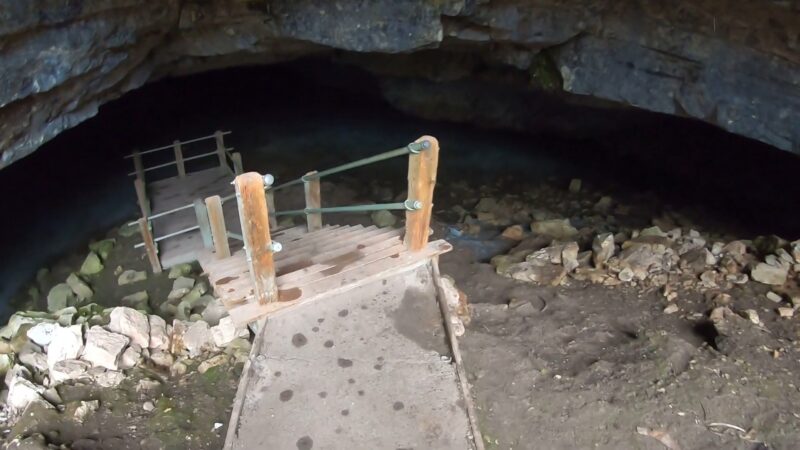Montana, known as the Treasure State because of its beautiful nature, has some hidden secrets. Its story begins with famous explorers Lewis and Clark from the 1800s. When they were exploring what’s now Montana, they met the Salish tribe.
The Salish people told them about an amazing cave system hidden away. Curious about this, Lewis and Clark decided to go on an adventure and explore the caves themselves.
One thing was certain – it wasn’t easy. They had to face steep cliffs, rough terrain, and thick plants, but they didn’t give up. After a couple of tough days, they finally found the entrance to the caves.
Nowadays, these caves are considered the wonders of Montana’s natural beauty. After years of exploring these caves myself, I can definitely confirm it.
I’ve put together a guide for your weekend break in Montana that will help you see the most stunning caverns on my list, check it here 👉 Cave weekend getaway trip
1. Bighorn Cavern
This is a gem you don’t want to miss! Bighorn Cavern is Montana’s largest underground cave network. The cave system is located in the south-central part of Montana. It was formed over millions of years and is continually evolving. The cave was first brought into the public eye in 1961.
The entrance is covered with a grate and a cage, accessible only with a key and under the guidance of an experienced trip leader. Rappelling into the cave leads to a large room called the Cloak Room.
There are 14 miles of known passages in Bighorn Cavern, offering exploration opportunities. New passages are continuously being discovered in the cave.
The cave formations include stalagmites, stalactites, cave popcorn, cave bacon, helictites, and more. It is home to a variety of wildlife, including bats, which can often be seen flitting about in the dim light.
Bighorn Cavern offers a unique opportunity to witness the slow, relentless power of nature. All I can say is that I was truly amazed by it.
2. Lick Creek
Tucked away in the Sapphire Mountains, Lick Creek Cave will offer you a raw and authentic caving experience. This wild cave is largely undeveloped and unlit, making it a true adventure for those who dare to explore its depths.
The main highlight of the cave is its big central room, filled with amazing rock formations. When you shine your headlamp, you’ll see lots of stalagmites coming up from the ground and stalactites hanging down like icicles from the roof.
The Cathedral Room at the end of the cave measures 405 feet by 465 feet.
The cave’s walls show a mix of colors, from bright white calcite to dark reds and browns from iron.
I’ll have to warn you that going into Lick Creek Cave is challenging. It can be slippery on the ground, and it’s easy to get lost in the dark. But for those who are prepared, the cave offers an unforgettable journey into the heart of the earth.
3. Lookout
Lookout Cave is located in the Little Rocky Mountains, not far from Glacier National Park. It’s a fascinating limestone cave filled with many passageways, rooms, and tunnels, decorated with beautiful stalactites and stalagmites formed over thousands of years.
The cave got its name from its history with outlaws in the late 1800s, who used it as a hiding spot and to watch for the police.
Now, the cave is a great place for both adventure and learning about history. Walking through its tunnels, you might feel like you’re stepping back into the times of those outlaws.
It’s a popular place for cave explorers because of its many challenging tunnels. But, even if you’re new to caving, you can join a guided tour to see its beauty safely. Just make sure to bring a strong flashlight and wear good shoes!
4. Pictograph
Pictograph Cave, located just outside of Billings, is a true historical treasure. This cave is named for the pictographs, or rock paintings, that adorn its walls.
These pictographs were created by Native American tribes over 2,000 years ago, and they offer a fascinating glimpse into Montana’s past. You’ll encounter a variety of pictographs, from simple handprints to complex scenes of hunts and battles.
Each pictograph offers insights into the lives and beliefs of the people who once called Montana home. The cave is part of a state park, which offers interpretive programs and guided tours.
Here you can connect with the past, learn about Montana’s rich cultural heritage, and experience the timeless beauty of nature.
5. Devil’s Chute
I believe that Devil’s Chute Cave is a challenge that only the bravest spelunkers dare to take on. Named for its steep entrance chute, which plunges into the darkness below, this cave is located in the Pryor Mountains.
Inside, the cave leads to many rooms and tunnels with interesting rocks. As you move through it, you’ll see stalagmites, stalactites hanging like lamps, and flowstones that look like waterfalls frozen on the walls.
Devil’s Chute Cave is for experienced cavers, but if you’re ready for it, the experience is very rewarding. The sense of accomplishment that comes from conquering Devil’s Chute Cave is a feeling that you’ll carry with you long after you’ve emerged from its depths.
6. Tears Of The Turtle
Tears of the Turtle is a cave of contrasts. This cave is named for its unique formations, which resemble tears streaming down a turtle’s face.
The cave is as beautiful as it is hard to explore, being one of Montana’s toughest caves.
The cave has a recorded depth of over 550 meters below ground.
The cave’s temperature ranges from pleasant at the entrance to near freezing at its depths. Tears of the Turtle Cave is formed in Cambrian Pagoda Limestone and is situated in a karst landscape. Despite its uniqueness, tourism in the area is minimal due to the cave’s remote location and difficulty of access.
7. Lewis and Clark Caverns State Park
No list of Montana’s caves would be complete without mentioning Lewis and Clark Caverns State Park. This is Montana’s first state park, and it’s home to one of the most decorated limestone caverns in the Northwest.
The caverns are named after the famous explorers Lewis and Clark that I’ve mentioned, although they never actually saw the caves. Instead, the caves were discovered by local ranchers in the late 19th century, and they’ve been a popular tourist attraction ever since.
The caverns are also home to a variety of wildlife, including bats, packrats, and a host of tiny invertebrates.
It’s definitely a place where you can experience the wonder of nature, the thrill of exploration, and the joy of discovery, all in one unforgettable adventure.
8. Royce
This cave is known for its large chambers, intricate passages, and stunning formations.
The cave’s main attraction is its “Cathedral Room,” a massive chamber filled with towering stalagmites and delicate draperies. You’ll get a chance to see a variety of formations, from flowstones that look like frozen waterfalls to helictites that defy gravity with their twisted shapes.
Royce Cave is a must-visit for any caving enthusiast. Don’t forget to bring a good headlamp, as the cave’s depths are shrouded in darkness.
9. Big Ice

Last but not least, we have the Big Ice Cave in the Pryor Mountains. This cave is named for its perennial ice formations, which can be seen year-round.
The walls of the cave show off different colors, from bright white ice to deep blues and purples when light shines through. Even though it’s cold inside, Big Ice Cave is very popular with visitors.
It provides a special cave adventure that everyone should try, whether you’ve explored caves before or it’s your first time. Just remember to dress warmly, as the cave’s temperature rarely rises above freezing!
FAQ
Final thoughts…
Montana’s caves are indeed a world of wonder. Each cave, with its unique history, geology, and ecosystem, offers a distinct adventure that is sure to captivate your attention and inspire you.
They are natural museums, classrooms, and playgrounds all rolled into one, providing opportunities for learning, exploration, and fun. if you choose to visit these caves, you won’t regret it, trust me.
I’m Noel Massey, your not-so-typical trailblazer who’s been into hiking for years while herding two mini adventurers, a.k.a. my sons. We’ve tackled trails that would make your GPS do a double-take. Join me as I share tales from the great outdoors, and share some handy tips you could use in the future.







